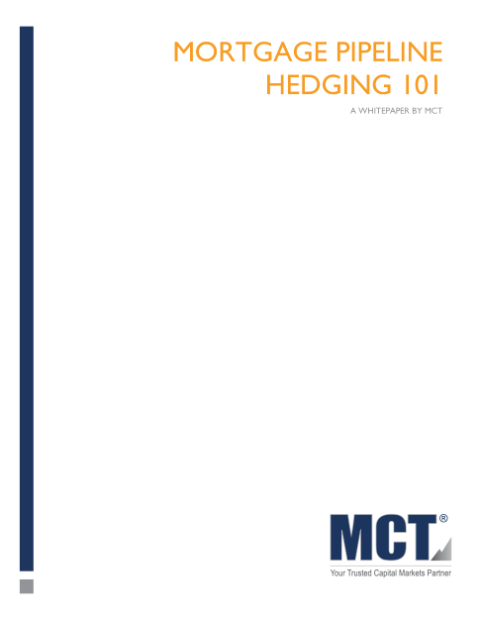
MCT Whitepaper: Mortgage Pipeline Hedging 101
Learn from our secondary marketing experts how you can use hedging as a tactic to mitigate risk and optimize profitability when selling mortgage loans.
This whitepaper will review information on moving to mandatory, the strategy of hedging, the benefits of hedging, and how to determine if you are ready.
Fill out the form to download Mortgage Pipeline Hedging 101.
Download Whitepaper
Hedging one’s mortgage pipeline typically produces the greatest return over long-term macroeconomic cycles, which is why it is considered an essential step in the growth of a mortgage lender.
About the Whitepaper:
MCT’s Hedging 101 whitepaper seeks to explain how hedging can be used as a vehicle to mitigate risk in the secondary market.
Topics Include:
- What is Mortgage Pipeline Hedging?
- Hedging Example and Process
- The Benefits of Hedging
- Are You Ready to Hedge?
Download our whitepaper today to learn more about mortgage pipeline hedging!

Featured Whitepaper Excerpts:
In the business of buying and selling assets, hedging is used as a vehicle to mitigate risk. In the secondary mortgage market, hedging an open pipeline can produce the greatest return regardless of the current market environment. Yet historically, it has been viewed as too complex or risky by some mortgage lenders. Download this whitepaper to debunk the myths and learn about this valuable strategy for maximizing profitability in the secondary market.
WHAT IS MORTGAGE PIPELINE HEDGING?
Hedging – An activity that protects an asset from market fluctuations by taking an offsetting position in a similar asset. Hedging is used to ensure the price change on the loans that have not yet closed is offset by the change in value of the hedging instrument. Hedging a mortgage pipeline helps to manage the pricing risk associated with the pipeline and ultimately optimize loan sale profitability.
WHAT ARE TBA (TO BE ANNOUNCED) MORTGAGE BACKED SECURITIES USED FOR WHEN HEDGING?
The forward contract TBA can be used to manage risk, and the delivery of the underlying securities is available but not necessary. Better said, most originators that are hedging do not deliver or create securities (MBS). The TBA strategy is akin to shorting a stock. Using TBAs allows for hedge positions to be added or removed quickly and inexpensively should loans in your pipeline “fall out,” new locks enter your locked pipeline or the pipeline risk profile change.
ARE YOU READY TO HEDGE?
MCT generally recommends that originators should seriously consider hedging a mortgage pipeline when monthly “hedgeable” volume reaches approximately $10 million. MCT typically moves clients to mandatory when volume is closer to $15 million or $20 million, but it is good to start thinking about getting prepared for the transition ahead of time. Once an originator has $15 to $20 million or more in “hedgeable” volume, the economics of hedging begin to clearly outweigh the costs. Over the long term, an originator should expect to make a 20 to 25 basis points lift over best-efforts.
